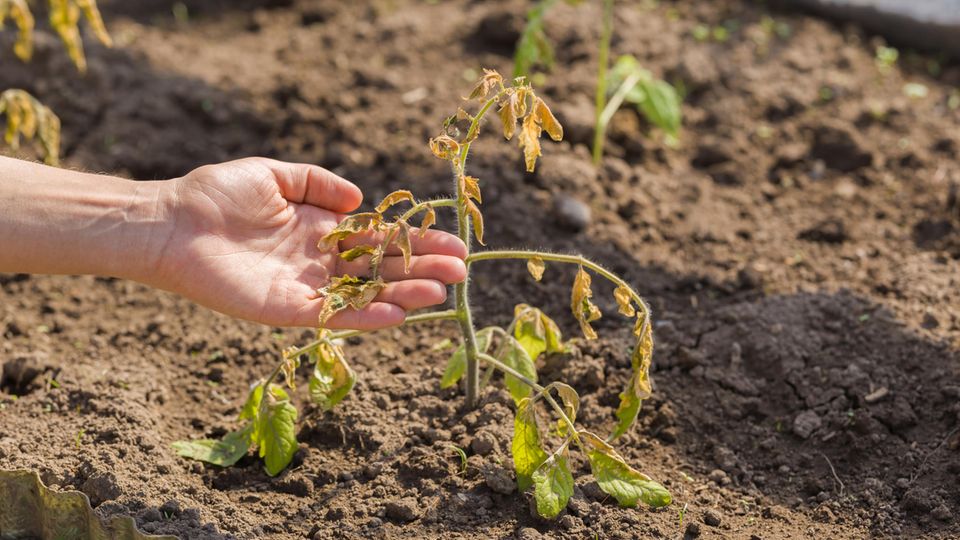Heavy feeder
Fertilize tomatoes: This is how you strengthen the nightshade plants outdoors
There are different ways and means of fertilizing tomatoes: In this case it is granular fertilizer
© Zbynek Pospisil/Getty Images
According to Statista, an adult eats up to 28 kilograms of tomatoes per year. At least as popular as eating the nightshade plants is growing them in the home garden. Tips for a bountiful harvest.
Tomatoes are quite easy to care for and still have certain demands on their environment: the right location, the right soil and the right care have a major influence on the harvest. To promote the growth of heavy feeders and make them more resistant to diseases – such as brown rot and powdery mildew – tomatoes should be fertilized regularly. The trick is to estimate the correct proportions, as too many of the nutrients they need (nitrogen, phosphorus, potassium, magnesium and sulfur) can lead to over-fertilization and harm the young plants. Below you will learn how and when you should fertilize tomatoes.
Which fertilizer is suitable for tomatoes?
- Garden compost is best suited for fertilizing outdoor tomatoes. Ideally, you add the soil to the beds in autumn to enrich the soil with nutrients until next spring. Alternatively, horse manure is also an option if you know a farmer who would provide you with the natural fertilizer.
- If you can’t use one or the other, provide your plants with one organic long-term fertilizer. It is available in powder form or as granules. Both variants are also added to the soil and incorporated – ideally before you sow or plant new tomatoes.
- Or you can make a kind of organic fertilizer yourself from natural ingredients: nettle manure. It not only supports the growth of the plants, but also strengthens them from the inside and makes the tomatoes more resistant to pests such as aphids. Read here how you can make nettle manure.
Fertilize tomatoes properly: how, when and how often?
The most important nutrients for tomatoes are nitrogen (for growth), phosphorus (for root and flower support) and potassium (for fruit production). However, since the nightshade plants are heavy feeders, i.e. crops with a large appetite, they extract all the nutrients they need from the soil in a short time. For this reason, it is important to fertilize the soil and therefore the tomatoes regularly. The right time for this is autumn, to enrich the soil with nutrients for the next season, or spring: ideally in several stages – first when planting, then when the second pair of leaves forms (not always absolutely necessary) and again when the first flowers/fruits appear. From then on at regular intervals.
Keep in mind that solid fertilizer takes longer than liquid fertilizer to be absorbed into the soil. It also makes sense to use different fertilizers from sowing to harvesting: when planting, horn shavings or organic long-term fertilizers tried and tested means. As soon as the heavy feeders form their first fruits, a Tomato and vegetable fertilizer be used because it contains a lot of potassium and magnesium. Special garden fertilizers are often used to promote the growth of leaves and shoots – but they can have a negative impact on flower and fruit formation.
Important NOTE: Please refer to the packaging to find out how to properly use an organic fertilizer – whether liquid or solid. Depending on the manufacturer, the dosage can vary.
How to recognize deficiency symptoms in tomatoes Yellow leaves are a typical sign of tomato deficiency © FotoDuets / Getty Images
If there are too few nutrients in the soil, you can see it in the young plants. But even if the soil has been fertilized too much, the nightshade plants show the first signs of deficiency. The following signs indicate that your tomatoes are not doing well:
The leaves turn yellow
Healthy tomato plants have green leaves. If these suddenly turn yellow, this is a warning signal that the soil does not contain enough nitrogen. But don’t panic: you can make up for the deficiency by adding a little Tomato fertilizer or work nettle manure into the soil.
The leaves are getting darker and darker
If the tomato leaves suddenly turn dark green (almost black), this is a sure sign that there is too much nitrogen in the soil: In other words, the plants have most likely been over-fertilized. There’s not much you can do to counteract the deficiency symptoms except wait – and stop using fertilizer until the tomatoes have recovered.
The leaves curl up
Rolled leaves also indicate over-fertilization of tomato plants. Here, too, it is recommended to stop enriching the soil with new nutrients and to wait (and hope) for the nightshade plants to recover on their own. However, the curled leaves no longer recover.
The flower bases turn brown
Brown spots around the flower bases (and therefore also brown fruits) are a typical sign of what is known as blossom end rot. This form of deficiency occurs when plants lack calcium – even if there is enough of it in the soil. Too little irrigation water or too much fertilizer with nitrogen is usually the trigger. The fruit can still be eaten, just cut off the brown parts later. To counteract the infestation, it is advisable to use something Algae lime to sprinkle the affected plants and then water the soil.
The leaves and stems turn brown
If brown spots spread on the leaves and stems of young tomato plants or they turn black and begin to wilt, these are typical signs of late blight. This is a fungus (Phytophthora infestans) that particularly likes to add to outdoor tomatoes. In order to combat the infestation, the use of plant protection products such as “Vegetable-mushroom-free” or “Special mushroom-free” be useful.
Sources: My beautiful garden, My harvest, Statista
You might also be interested in:
This article contains so-called affiliate links. Further information are available here.



